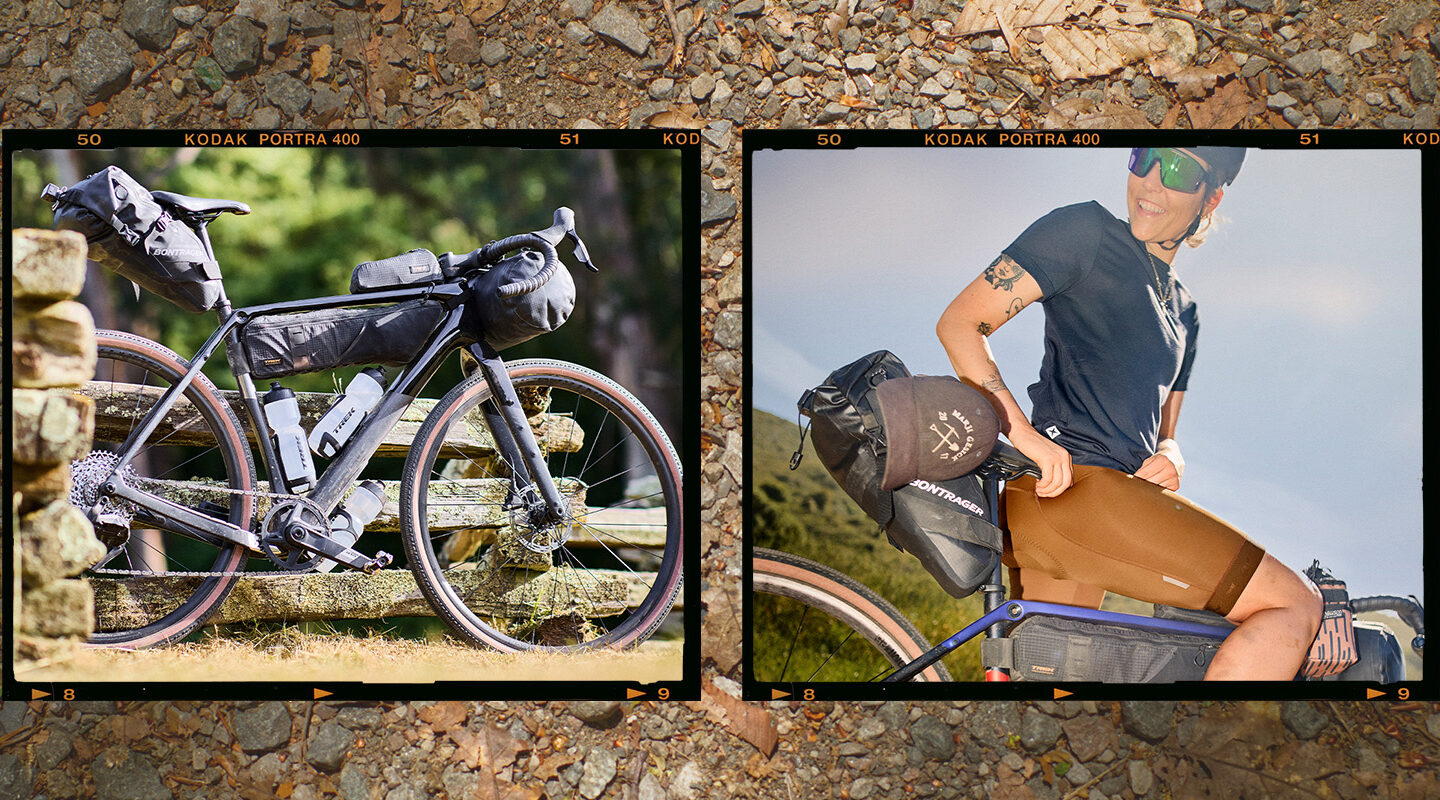- 17 August, 2024
- Trek
Guy Kesteven | How to pack for bikepacking A bikepacking gravel adventure is a thrilling escape into the great outdoors, but prepping and packing is a skill in itself. Our expert guide will ensure you’re carrying everything you need for a safe and enjoyable experience in the most efficient, easy-to-use way. That will make sure you’ll still have loads of space left for the most important thing of all: Having a great time.
Bike prep
You won’t get far on a broken bike. Ensure your gears work and your brake pads have plenty of life left. Don’t set off with leaky, cracked or cut tyres and check the tread is appropriate for the terrain you’re going to ride. If in doubt it’s better to roll a bit slower and have more control with chunkier rubber, especially on a loaded bike.
If you’re unsure how to self-check, book your bike in with your local bike shop well ahead of your adventure so they have time to properly sort out any problems.
What spares you should take depends on how far you’re going from bike shops and how rough the riding is. A multi-tool that can tighten all your bolts and fix your chain is essential though, as are a spare chain link, spare inner tubes and a pump. Add a plug kit and a C02 inflator if you’re running tubeless tyres. A spare cable or spare battery for your gears takes up barely any room and your bike will definitely thank you if you take chain lube on a multi-day ride.
Dress for success
When it comes to clothing, versatility is key so choose kit that works on and off the bike. Thin, fast-drying clothing works better for wet weather and washing and can be layered to add warmth. Wool works particularly well for bike packing base layers and socks because it doesn’t like roadkill even after days of off-road roaming. Weather can change fast in the wild and long days can leave you cold on a night even if it’s warm too so a warm jacket that packs down super small is an expedition essential.
Make sure your shorts, gloves and shoes are comfortable for long days too and always stick with tried and tested gear for epic adventures.
Expedition essentials
Escaping into the great outdoors is awesome but make sure you can stay healthy and find your way home again. A GPS is great for keeping you on track but always back it up with a map in case of battery or other issues. You’ll need battery packs and cables to recharge your phone, GPS and whatever you’re using as a safety beacon juiced up too. Small bike lights can literally be a lifesaver if you end up riding in the dark and they can also double as a campsite torch.
A first aid kit with painkillers is a definite essential and a small wrap of duct tape and some zip ties can repair tents, tyres, clothing, loose bike parts etc.
Don’t forget self-care items like “toothpaste/toothbrush, suncream, soap, toilet paper and any bug spray, medicines or sanitary products you might need either“.

Pro Flat Pack
The Pro Flat Pack has everything you need to fix a flat and get back on the bike quickly in an aero, easy-to-grab package. This all-in-one kit provides essential items needed to fix a flat tyre with additional pockets for money and ID, plus extra soft, padded materials to ensure you won't be bothered by the poke of a tool while it's stashed in your back pocket.

Rapha
Rapha has won the hearts of cyclists worldwide with a lineup of elegant cycling jerseys, bib shorts, and accessories that elevate comfort and style on the bike. Through thoughtful designs and craftsmanship, Rapha creates gear for you to live life by bike — because it's so much more than just a ride.

Wahoo
Whether you need a GPS for mountain biking, gravel rides, or unfamiliar roads, Wahoo cycling computers offer powerful features to track your performance, navigate new routes and stay connected before, during and after your rides.
Camp life
What sort of camping kit you take depends on how wild your vibe is and the likely weather conditions. Bivvy bags are the ultimate in space and weight efficiency but spending all night shivering isn’t a great start for a happy day of riding. Then again it’s easy to overload yourself and your bike with a bulky tent, thick mat and Arctic-rated sleeping bag when just using your leggings and duvet jacket as nightwear would keep you as warm.
Cooking equipment depends on your catering plans but using meals that cook in their packaging or choosing ingredients that can share the same pot at the same time will save weight, space and washing.
Don’t forget that cooking gear – and multi-person tents, first aid kits and bike tools – can be shared through your riding group to spread the load too.
Hungry isn’t happy
One thing we’d never take less of is food and drink! If you’re hungry we guarantee you won’t be happy and long days in the wild chew through calories like a grizzly bear in a dumpster. Take a variety of food that you actually like so you’re motivated to keep eating and remember that while you’ll go fast on sugar you’ll go far on fat.
“Don’t forget you might need water for cooking, brushing teeth etc as well as drinking. Even if you think you’ve got enough always fill bottles back up at every opportunity in case the next shop is shut or tap is turned off. Because riding the last hill with a full bottle and a pocket full of snacks you didn’t need is way better than crawling up that climb thirsty and starving.”
Bag it up
OK so now you’re staring at a huge heap of kit and food and wondering how you’re going to get it all on your bike and in what order. Before you start stuffing the basic rule is to put the stuff you need quickest where you can reach it easiest.
That means overnight kit goes in first. Put the heavier gear like stoves/tents etc in your seat pack or rear panniers where it messes with handling less. Lighter, bulky stuff like sleeping bags and mats can then go in a bar bag or even a backpack.
Then top those bags up – or use a frame bag for – ‘during the day’ stuff like charging kits for electricals so you can boost batteries at a lunch stop, suncream, first aid kit, maps and reserve snacks for restocking pockets later. If the weather looks settled coats can get squashed in here too, otherwise strap them on the outside of bags with a bungee cord ready to grab as soon as the rain starts.
Now use top tube bags, jersey pockets, hip packs etc. for snacks, phones, camera, cash etc. that you’ll want to grab regularly while riding. A spare stash bag and some elastic/rubber straps can be super useful for extras you might pick up (or eat on the the first day) too.
Top Tip “Remember to leave a secure pocket ready for wrappers or any other litter you might see too as we should all try and leave the outdoors cleaner than we find it.”
Packing hacks
Stuffing kit into bags randomly can waste a lot of space, so here are our favourite packing hacks.
Rolling clothes individually or into easy to find bundles like a shirt, shorts and socks for each day compresses them down so they take up a lot less space. Start by folding over the top to make a pocket and then roll up tightly before tucking the roll into the top fold to make a neat parcel.
If your jacket doesn’t have a stuff pocket or pack sack of it’s own, just stuff it down the inside of it’s own sleeve to make a compact sausage.
Top Tip “Never leave empty space. Fill cooking pans with food packets, overnight toiletries etc. and stuff clothing rolls into shoes. Always push everything as far down into your bags as possible too as wrinkles on the outside mean wasted space inside.”
How much is too much?
Only you can really decide where you sit on the sliding line between compact speed and cruiser comfort. Is a bivvy bag under a bush, eating from gas stations and wearing the same kit all week survival style your vibe? Or do you want to be cosy, dressed to impress and cooking a camping banquet every night?
Just be aware that every item you add to your kit list will make the hills harder though – particularly if you have any push or hike-a-bike sections. An overloaded bike is much less fun on twisty singletrack trails and harder to handle on technical trails too. Plus you’d be surprised how minimal you need to go before you come back having used everything you took.
Pre-ride testing
One great way to find out if you’ve packed too much – and an essential for checking everything works OK anyway – is a pre-ride test. Once around the block on smooth roads isn’t going to cut it though so try and ride similar surfaces to your planned adventure for at least an hour to check your bags don’t slip, rub or rattle and your bike still handles OK. Obviously, the longer you can test basic bike position and crucial stuff like saddles and shorts before you go the better. Be sure to try out your camping kit as well, even if it’s just in the garden because trying to put up a tent for the first time in the dark when you’re tired is a definite buzz kill.
Top Tip “Finally, laying out all your kit before packing doesn’t just look awesome on Instagram, it’s also a great way to double-check check you’ve got everything you need for a fantastic bike packing experience.”
Top 5 packing for bike packing tips
- Check your bike is safe and expedition ready
- Take versatile, layerable clothes and roll them tight
- Pack in order of easy access priority
- Tasty food and plenty of water are the recipe for a happy adventure
- Double-check our kit with a layout and pre-ride to be sure you’re sorted

How to ride gravel
Whether you’re gearing up for your first-ever gravel adventure or planning your biggest trip yet, this guide can help you grow your skills and enjoy any surface or scenario you encounter on the road less travelled. Basic techniques by Guy Kesteven

How to Plan as Gravel Ride
Gravel riding has taken the cycling world by storm, offering a unique blend of adventure, challenge, and scenic beauty. Whether you're a seasoned rider or new to gravel, proper planning is essential for a safe and enjoyable journey. In this guide, we'll walk you through the steps to plan a memorable gravel ride, supported by stunning photography and informative video. By Guy Kesteven

About the Author: Trek
Our mission: we build only products we love, provide incredible hospitality to our customers, and change the world by getting more people on bikes.





